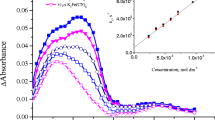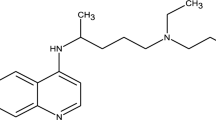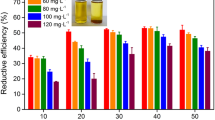Abstract
The effects of dissolved chemicals such as NaOH, NaI, methyl ethyl ketone (MEK), and methyl isobutyl ketone (MIBK) on solution pH after gamma irradiation were investigated. Upon irradiation with 1.6–24 kGy of gamma radiation (0.4–6 kGy h−1), the pH of the NaOH solutions decreased, while the OH− consumption increased with increasing initial solution pH. This was attributed to acid–base neutralization between the OH− in the solutions and the acidic species (HO2· and ·NO2) formed by irradiation. The pH of the acidic NaI solution increased after irradiation with 8 kGy dose (at 2 kGy h−1), which was attributed to I− oxidation by the products of water and air radiolysis. The pH values of the MIBK and MEK solutions decreased from 7 to 4.5 or lower upon irradiation with 40 kGy dose (at 10 kGy h−1), which indicates that the alkyl groups of the ketones do not significantly affect the rates of decomposition by irradiation. The pH of the mixed solution of ketone and NaI was in the range of 6.7–6.9 before irradiation but decreased to 4.5 after irradiation with 40 kGy dose. In the mixed solutions, CH3COR and I− competed with each other to contribute to pH change.




Similar content being viewed by others
References
Paquette J, Torgerson DF, Wren JC, Wren DJ (1985) Volatility of fission products during reactor accidents. J Nucl Mater 130:129–138
Ishigure K, Shiraishi H, Okuda H, Fujita N (1986) Effect of radiation on chemical forms of iodine species in relation to nuclear reactor accidents. Radiat Phys Chem 28:601–610
Cronenberg AW, Osetek DJ (1987) Fuel morphology effects on the chemical form of iodine release from severely damaged fuel. J Nucl Mater 149:252–260
Lucas M (1988) Radiolysis of cesium iodide solutions in conditions prevailing in a pressurized water reactor severe accident. Nucl Technol 82:157–161
Beahm EC, Weber CF, Kress TS, Parker GW (1992) Iodine chemical forms in LWR severe accidents. Oak Ridge National Laboratory, Oak Ridge
Bosland L, Funke F, Girault N, Langrock G (2008) Paris project: radiolytic oxidation of molecular iodine in containment during a nuclear reactor severe accident. Part 1. Formation and destruction of air radiolysis products. Experimental results and modeling. Nucl Eng Des 238(3542):3550
Tigeras A, Bachet M, Catalette H, Simoni E (2011) PWR iodine speciation and behaviour under normal primary coolant conditions: an analysis of thermodynamic calculations, sensibility evaluations and NPP feedback. Prog Nucl Eng 53:504–515
Cantrel L (2006) Radiochemistry of iodine: outcomes of the CAIMAN program. Nucl Technol 156:11–28
Clément B, Cantrel L, Ducros G, Funke F, Herranz LE, Rydl A, Weber G, Wren JC (2007) State of the art report on iodine chemistry. Organisation for Economic Co-Operation and Development
Postma AK, Zavadoski RW (1972) Review of organic iodide formation under accident conditions in water-cooled reactors. Battelle Pacific Northwest Laboratory, Washington
Beahm EC, Wang YM, Wisbey SJ, Shockley WE (1987) Organic iodide formation during severe accidents in light water nuclear reactors. Nucl Technol 78:34–42
Wren JC, Ball JM, Glowa GA (1999) Studies on the effects of organic-painted surfaces on pH and organic iodide formation. In: Iodine aspects of severe accident management workshop proceed, Vantaa
Wren JC, Ball JM, Glowa GA (1999) The interaction of iodine with organic material in containment. Nucl Technol 125:337–362
Wren JC, Ball JM, Glowa GA (2000) The chemistry of iodine in containment. Nucl Technol 129:297–325
Taghipour F, Evans GJ (2000) Radiolytic organic iodide formation under nuclear reactor accident conditions. Environ Sci Technol 34:3012–3017
Moriyama K, Tashiro S, Chiba N, Hirayama F, Maruyama Y, Nakamura H, Watanabe A (2010) Experiments on the release of gaseous iodine from gamma-irradiated aqueous CsI solution and influence of oxygen and methyl isobutyl ketone (MIBK). J Nucl Sci Technol 47:229–237
Wren JC, Jobe DJ, Sanipelli GG, Ball JM (2000) Dissolution of organic solvents from painted surfaces into water. Can J Chem 78:464–473
Lin CC (1980) Chemical effects of gamma radiation on iodine in aqueous solutions. J Inorg Nucl Chem 42:1101–1107
Ashmore CB, Gwyther JR, Sims HE (1996) Some effects of pH on inorganic iodine volatility in containment. Nucl Eng Des 166:347–355
Jung SH, Yeon JW, Hong SY, Kang Y, Song K (2015) The oxidation behavior of iodide ion under gamma irradiation conditions. Nucl Sci Eng 181:191–203
Hong SY, Jung S-H, Yeon J-W (2016) Effect of aluminum metal surface on oxidation of iodide under gamma irradiation conditions. J Radioanal Nucl Chem 308:459–468
Barkatt A, Barkatt A, Sousanpour W (1982) Gamma radiolysis of aqueous media and its effects on the leaching processes of nuclear waste disposal materials. Nucl Technol 60:218–227
Beahm EC, Lorenz RA, Weber CF (1992) Iodine evolution and pH control. Oak Ridge National Laboratory, Tennessee
Driver P, Glowa G, Wren JC (2000) Steady-state γ-radiolysis of aqueous methyl ethyl ketone (2-butanone) under postulated nuclear reactor accident conditions. Radiat Phys Chem 57:37–51
Glowa G, Driver P, Wren JC (2000) Irradiation of MEK-II: a detailed kinetic model for the degradation of 2-butanone in aerated aqueous solutions under steady-state γ-radiolysis conditions. Radiat Phys Chem 58:49–68
Kim M, Kim T, Yeon J-W (2018) Formation of CH3I in a NaI and methyl alkyl ketone solution under gamma irradiation conditions. J Radioanal Nucl Chem 316:1329–1335
Bielski BHJ, Cabelli DE, Arudi RL, Ross AB (1985) Reactivity of HO2/O2− radicals in aqueous solution. J Phys Chem Ref Data 14:1041–1100
Sander R (1999) Compilation of Henry’s law constants for inorganic and organic species of potential importance in environmental chemistry. Max-Planck Institute of Chemistry, Air Chemistry Department, Mainz
Buxton GV, Greenstock CL, Helman WP, Ross AB (1988) Critical review of rate constants for reactions of hydrated electrons, hydrogen atoms and hydroxyl radicals (·OH/·O−) in aqueous solution. J Phys Chem Ref Data 17:513–886
Koppenol WH, Butler J (1985) Energetics of interconversion reactions of oxyradicals. Adv Free Radic Biol Med 1:91–131
Catherine EH, Alan GS (2012) Inorganic Chemistry, 4th edn. Pearson, London, p 522
Acknowledgements
This work was supported by the Nuclear Research and Development Program through a grant by the National Research Foundation of Korea funded by the Ministry of Science and ICT, Republic of Korea (No. 2017M2A8A4015281).
Author information
Authors and Affiliations
Corresponding author
Additional information
Publisher's Note
Springer Nature remains neutral with regard to jurisdictional claims in published maps and institutional affiliations.
Rights and permissions
About this article
Cite this article
Kim, M., Hong, S.Y., Kim, T. et al. Change in the pH of NaI and methyl alkyl ketone solutions under gamma irradiation. J Radioanal Nucl Chem 326, 121–127 (2020). https://doi.org/10.1007/s10967-020-07346-8
Received:
Published:
Issue Date:
DOI: https://doi.org/10.1007/s10967-020-07346-8




